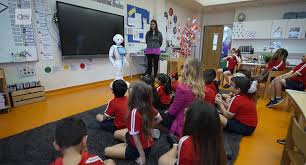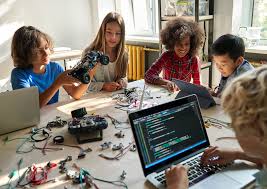The education landscape in the United Arab Emirates (UAE) is rapidly evolving. As part of the country’s commitment to innovation and technology, schools are introducing coding and robotics into their curricula. These subjects are not only preparing students for the digital future but also nurturing essential problem-solving and critical-thinking skills.
Why Coding and Robotics Matter
Coding and robotics are no longer viewed as extracurricular activities. Instead, they have become core components of the learning experience. With technological advancements influencing every sector, students need to develop digital literacy to remain competitive in the job market.

By learning to code, students understand how software and applications work. Robotics, on the other hand, combines mechanics, electronics, and programming, offering a hands-on learning experience. Together, they enhance creativity, analytical thinking, and teamwork.

Government Initiatives Supporting Tech Education
The UAE government has been proactive in integrating technology into education. Programs like the One Million Arab Coders initiative aim to teach coding to individuals across the region. Additionally, the Mohammed bin Rashid Smart Learning Program has introduced digital learning tools in classrooms, further encouraging the study of STEM (Science, Technology, Engineering, and Mathematics) subjects.
Many public and private schools now offer coding classes from primary levels, ensuring students are exposed to the fundamentals of programming early on. Schools also participate in robotics competitions such as the First Lego League and the World Robot Olympiad, fostering innovation and collaboration.

Benefits of Coding and Robotics in Schools

- Enhances Problem-Solving Skills: Coding challenges students to break down complex problems into manageable steps. Robotics adds an extra layer of practical application, encouraging students to think critically.
- Promotes Creativity: Whether it’s designing a robot or developing a simple application, coding fosters creativity and innovation. Students often experiment with different solutions and learn from their mistakes.
- Encourages Teamwork and Collaboration: Robotics projects often require teamwork, simulating real-world scenarios. Students learn how to communicate effectively, resolve conflicts, and contribute to group efforts.
- Prepares Students for Future Careers: As AI, automation, and software development become more prevalent, students with coding knowledge will have an advantage in the workforce.
Real-Life Examples from UAE Schools
Several UAE schools are leading the way in coding and robotics education. For instance, GEMS Education offers robotics clubs and coding workshops as part of its curriculum. The American School of Dubai provides hands-on coding classes using platforms like Scratch and Python, catering to different age groups.
Furthermore, students from the Dubai International Academy have showcased their robotic creations at international events. Schools are also collaborating with companies like Microsoft and Apple to provide students with the latest tools and resources.
Challenges in Implementing Coding and Robotics
While there is significant progress, challenges remain. Not all schools have equal access to resources and funding. Providing training for teachers to effectively teach coding and robotics is another concern. Additionally, keeping students engaged with challenging yet enjoyable content requires continuous curriculum development.
The Future of Tech Education in the UAE
Looking ahead, coding and robotics will likely become even more embedded in the UAE school curriculum. Partnerships between educational institutions and tech companies will continue to grow, providing students with hands-on experience and mentorship opportunities.
The UAE’s focus on becoming a knowledge-driven economy means students will graduate with the technical skills needed for success. By investing in coding and robotics education today, the country is ensuring a generation of innovators and problem solvers for tomorrow.
For parents and students interested in exploring coding and robotics, many schools offer after-school programs and coding boot camps. Platforms like Code.org and Tynker also provide accessible, engaging lessons for learners of all ages.
Conclusion
Coding and robotics are not just subjects; they are pathways to the future. With strong government support, enthusiastic educators, and curious students, the UAE is setting a benchmark in tech education. Whether students dream of developing the next groundbreaking app or building robots that solve real-world problems, their journey starts in the classrooms of today.
Also read: Your Ultimate Guide to Study Abroad Opportunities from the UAE














